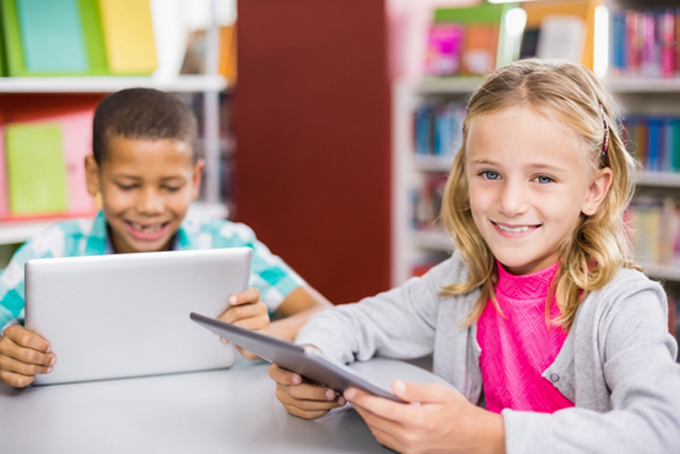 Quality early childhood classrooms are language rich and full of opportunities for children to learn through storytelling, exploration, problem-solving, socializing, and inquiry-based activities. Moreover, early childhood teachers use a plethora of diverse tools that foster literacy and language and spark children’s interest to learn and develop. Literacy is seamlessly embedded throughout the day and exposure to rich and robust language is intentional and meaningful. However, often these rich environments neglect to include technology as another important tool to build language and literacy.
Quality early childhood classrooms are language rich and full of opportunities for children to learn through storytelling, exploration, problem-solving, socializing, and inquiry-based activities. Moreover, early childhood teachers use a plethora of diverse tools that foster literacy and language and spark children’s interest to learn and develop. Literacy is seamlessly embedded throughout the day and exposure to rich and robust language is intentional and meaningful. However, often these rich environments neglect to include technology as another important tool to build language and literacy.
According to a joint position statement of the National Association for the Education of Young Children (NAEYC) and the Fred Rogers Center for Early Learning and Children’s Media at Saint Vincent College, technology can support learning and development when it is used appropriately and intentionally by a teacher well versed in developmentally appropriate practices. And although there are screen time debates and fear of young children spending too much time on devices, there are no- and low-tech choices that align with and reinforce the goals and vision of an early childhood classroom.
One such prospect is to incorporate basic coding games and screenless coding devices into project-based learning and centers. Coding affords children the opportunity to acquire and practice communicating with clarity and precision, while also encouraging decision-making, risk-taking, creativity, visualization, and problem-solving. Further, coding develops persistence, resilience, and confidence.
In layman’s terms, coding is a basic language of the digital world, directing computer-based technologies on what to do and how to operate. It requires exact step-by-step instructions to operate a device correctly. While there is much more involved, young children can begin to develop the necessary habits and processes of coding that can transfer into more complex coding later on. The following are suggestions for getting started and incorporating coding language in the early childhood classroom with no- and low-tech solutions.
No tech and unplugged
Young children begin to develop the language, vocabulary, and the processes of coding without a device or screen using body movement, games, and storytelling. In order for unplugged coding to work in the classroom, children must use precise language and communicate exact commands. Following are ideas from different early childhood classrooms for precoding.
- To get started with basic commands and vocabulary, create directional command cards with symbols or write them on the whiteboard for students to physically execute as the card is pulled or as the “programmer” directs (similar to Simon Says). Children get in the habit of following a specific command tells them when and how to move. Like robots or devices, children can’t move until directed. Eventually, children transition into the role of programmer and practice clear communication and strategic thinking to move peers within the grid.
- Incorporate a human coding grid on the floor to visually represent space and boundaries. Have children work together and take turns assuming the role of game programmer. The programmer flips a series of 2–3 cards and communicates precise directions for the teammates to execute. Include obstacles in the grid to challenge children to be flexible and creative in their thinking and choice of commands.
- Create a storytelling grid with familiar books. Take a favorite picture book and plot out different setting or events across the grid. Ask children to move a character through the story grid, following the correct order of events and retell the story as they go. This not only encourages students to recall story elements, but also reinforces coding essentials and clear communication. Children can also create their own storylines, characters, and coding cards. Variations are numerous, and I suggest following the embedded NAEYC link to get a better idea of how to incorporate storytelling with coding grids and extend coding play in the classroom.
Low tech and screenless
A next logical step is to transition children to operating a device with basic codes. There are a number of coding bots that are the perfect fit for different early childhood settings. Most require minimal setup, and many are screenless, encouraging children to explore and manipulate physical coding pieces to control a bot.
- Cubetto is especially interesting and appealing because of its natural aesthetic, minimalist design, and open-ended features. Children arrange tactile tiles on a board to control the movements of a robot. Although Cubetto comes with premade mats, children can design their own courses and experiences. This is a perfect transition from the low-tech coding activities described previously and appropriate for ages 3–6.
- Similar screenless devices include Beebots, Code-a-pillar, Matatalab Coding Set, and Botley. The devices are low-risk, hands-on, and high-challenge and embolden children to fail and persevere through tasks.
Incorporating coding through stories, games, and screenless bots is a fantastic way to reinforce and foster a language-rich classroom and introduce children to future skills and thinking. For more information or anyone interested in how coding fits into an early childhood classroom, please take a look at our ILA 2018 Conference presentation in collaboration with the USF Preschool for Creative Learning.
Stephanie Branson, an ILA member since 2015, is a PhD candidate at the University of South Florida, pursuing literacy studies and elementary education with a special focus on digital literacies and teacher development. Connect with her on Twitter @blueskysb.
This article is part of a series from the International Literacy Association Technology in Literacy Education Special Interest Group (TILE-SIG).